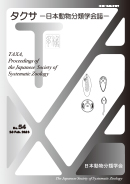Volume 54
Displaying 1-9 of 9 articles from this issue
- |<
- <
- 1
- >
- >|
JSSZ SYMPOSIUM 2022
-
2023 Volume 54 Pages 1-2
Published: February 28, 2023
Released on J-STAGE: March 07, 2023
Download PDF (387K) -
2023 Volume 54 Pages 3-10
Published: February 28, 2023
Released on J-STAGE: March 07, 2023
Download PDF (13988K) -
2023 Volume 54 Pages 11-16
Published: February 28, 2023
Released on J-STAGE: March 07, 2023
Download PDF (10422K) -
2023 Volume 54 Pages 17-22
Published: February 28, 2023
Released on J-STAGE: March 07, 2023
Download PDF (2911K) -
2023 Volume 54 Pages 23-35
Published: February 28, 2023
Released on J-STAGE: March 07, 2023
Download PDF (16052K) -
2023 Volume 54 Pages 36-41
Published: February 28, 2023
Released on J-STAGE: March 07, 2023
Download PDF (11791K)
ARTICLES
-
2023 Volume 54 Pages 42-48
Published: February 28, 2023
Released on J-STAGE: March 07, 2023
Download PDF (20951K) -
2023 Volume 54 Pages 49-58
Published: February 28, 2023
Released on J-STAGE: March 07, 2023
Download PDF (4440K) -
2023 Volume 54 Pages 59-66
Published: February 28, 2023
Released on J-STAGE: March 07, 2023
Download PDF (2568K)
- |<
- <
- 1
- >
- >|
